

October, 2022 Generative AI is the next step in software. It’s a new level of human-machine partnership. It turns deep learning engines into collaborators to generate new content and ideas nearly like a human would.
We now have high-quality, cheap, fast AI models for generating text, images, videos, software code, music, voice, 3D models and more – none of which is copyrighted, and is not plagiarized.
AI models are the enabling base layers of the stack. The top layers will be thousands of applications.
NFX started investing in the space over a few years ago and has invested in 18 Generative AI companies so far with more to come.
Founders: Today, we are encouraging you to create companies in this area now to catch the best part of the tech adoption cycle. This essay is for you.
If you are an investor or an angel who is focused on this new area, head to Signal and change your profile so you show up on the list of Generative AI investors.
So What’s New About Generative AI?
1. A new Internet topology
Until today, the Internet has been characterized by making database queries to get 1) a stored piece of 2) old content 3) from the center, out to you on the edge of the network.
Generative Tech changes the topology of the Internet because now 1) unique pieces of content are 2) generated at the edge of the network 3) in real time by your action. That’s a major shift, which typically opens up Founder opportunities.
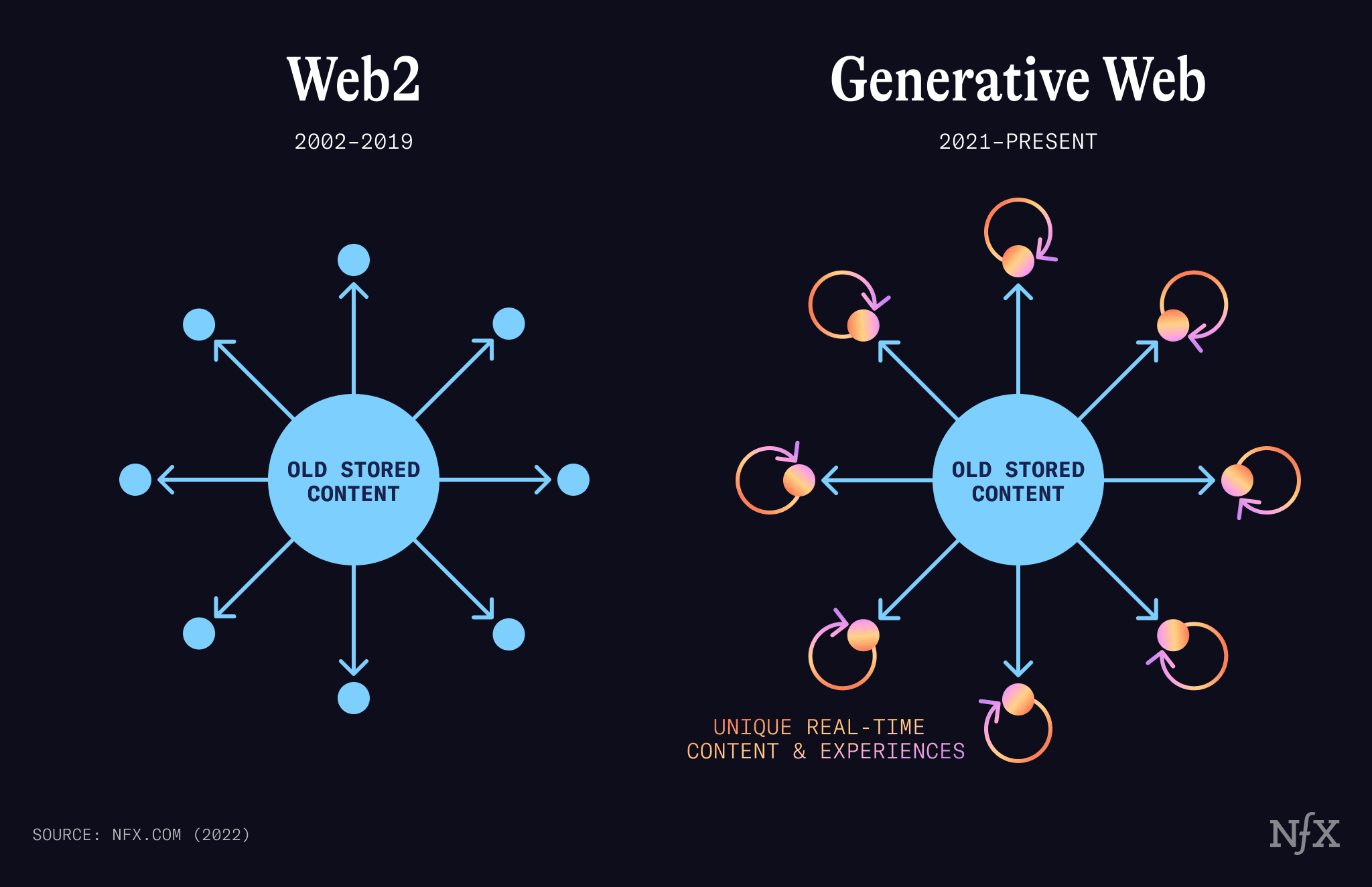

If Web1 was “read only,” and Web2 is “read-write,” and then Generative Tech is “read-write-generate” then that makes Web 3 “read-write-generate-own.” Generative Tech is now happening in parallel to Web3 and moving faster. If crypto hadn’t happened, we’d probably be calling THIS Web3. But we do have crypto, so we call this Generative Tech, but other names could be Web3A, Generative Web or even Generative Internet.
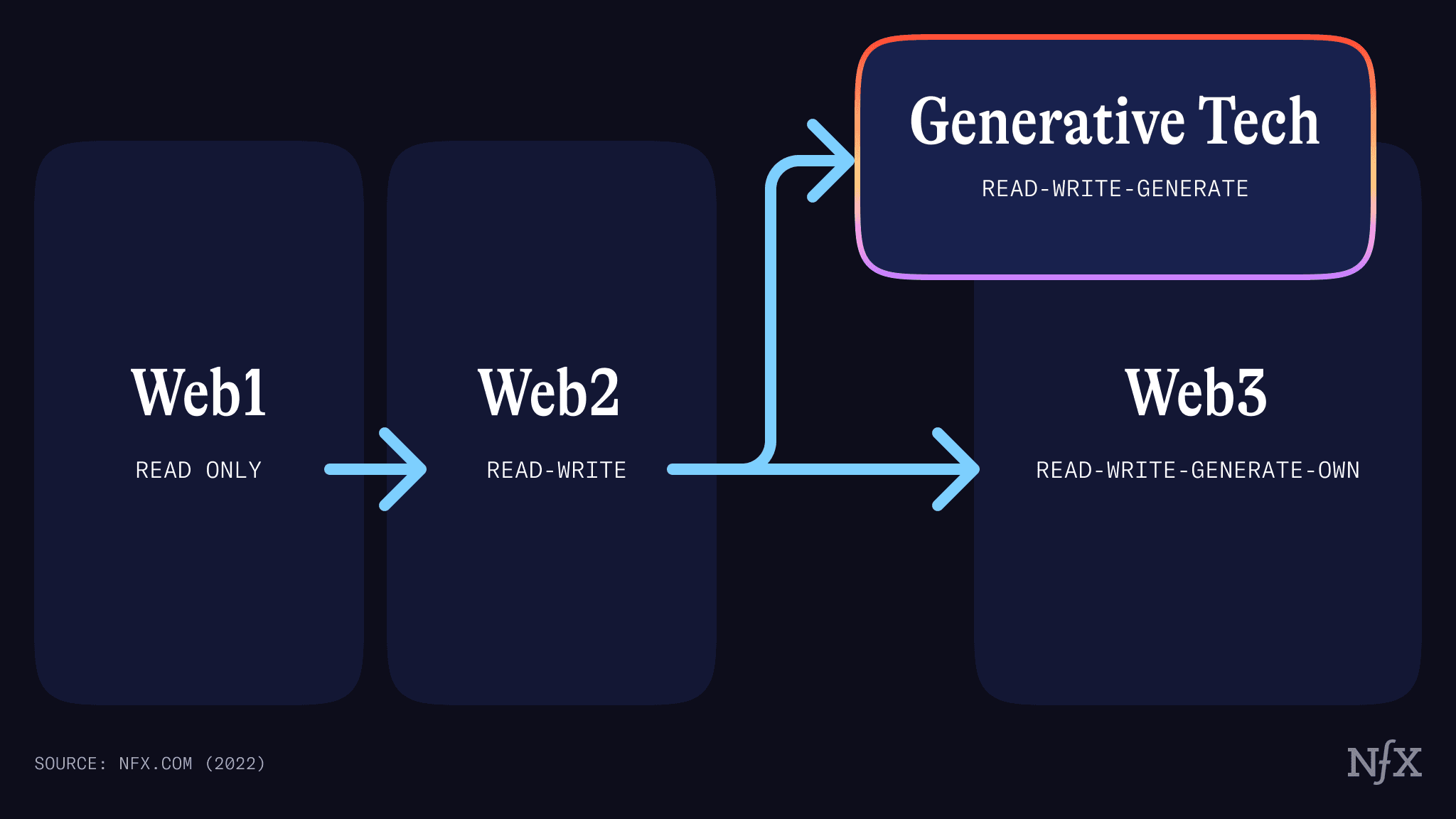

2. Human activities will now change quickly.
1-2 billion knowledge workers will become faster and better at their jobs. Some will be able to do jobs they couldn’t do before. New TYPES of jobs will be created. And while some jobs will be downgraded, threatened, eliminated – and that will cause fear and self doubt in 10s of millions of workers in the next 36 months – the expansion of people’s abilities, productivity, and efficiency will vastly outstrip the losses over all, generating trillions of dollars of value.
For knowledge workers and creatives, going from zero to one in their minds will never be the same. For instance, writers, students, marketers, coders, architects, graphic designers, musicians, videographers, sales development reps, customer service reps, and screenplay writers, who are paid go from zero to something useful will now be using these tools to generate their first ideas.
Until now, software has been used to refine our initial ideas into something useful; it was responsible for the second half of the process, if you will, of going from zero to something useful. But these new generative tools help you with the first half of the process, taking you from nearly zero to a lot of initial ideas. And then the old software tools pick up from there and take you the rest of the way.
Until now, software couldn’t solve the zero to one problem because it worked FOR us. Generative Tech will work WITH us from the beginning of any project.
Today and for the next few years, this will feel surprising and in many ways scary. Because those creative moments where you go from zero-to-initial-ideas has always felt so uniquely human, because it has been so mysterious. The ideas once thought to come unpredictably only through people’s minds and souls, emerging from talent, or training, often associated with special people – will now be generated by something which is not a human, not a co-worker or collaborator… and something that is not you. This will be disturbing to many people. However, as with most new human-machine interfaces, we’ll get through the discomfort and get used to it.
In the next 10 years, we will expect software to collaborate with us. It will be the new normal.
Steve Jobs said in 1980 that the Apple personal computer was a bicycle for the human mind. You might say that Generative Tech is a rocketship for the human mind. The makers of these AI models might say they are actual minds. No doubt they will get there. We’ve been talking about the inevitability of software-based minds since the 50s. The first example of the dawn of this era we felt as a culture was in 1997 when IBM’s Deep Blue beat Kasparov in chess. The next big leap was when AlphaGo definitively beat Lee Sedol in the game of Go in 2016.
Starting in 2022, Generative Tech is going to have an impact on billions of workers where they live.
This is a very different level. This is the skillful creation of new things.
What Changed So That Generative AI Is Happening Now?
The recent availability of open-source alternatives to proprietary generative AI models from Open AI is what caused it to tip wide open in the last 6 months. In short, Eleuther.ai’s GPT-NeoX-20B, launched Feb 2022, is the open source alternative to OpenAI’s GPT-3 for text generation. StabilityAI’s Stable Diffusion, launched August 2022, is the open source alternative to OpenAI’s DALL-E 2 for images and videos. Both have been game changers on price, quality and ease of access. The cost to generate images has dropped 100X in the last 2 months. (Stability announced a $100M raise three days ago). The friction to generate output from these models through web and mobile has become “about 10X easier” in the last 6 months.
Quality generated text, images, code, speech, etc is rapidly reaching human quality. Many feel we’re passing the Turing Test in several of these content categories already. It’s hard to measure, but you know the quality when you see it. As the 2021 Stanford University AI index noted, AI, for some constrained applications, has moved to a “sufficiently high standard that humans have a hard time telling the difference between synthetic and non-synthetic putouts.” We are headed toward “generative everything.”
Because of all these changes, the amount of experimentation has “about 20X’d in the last two months.” This accelerates the number of applications providing value and introduces even more people to the community.
It’s an old story in technology: the barriers go down, and boom…Cambrian explosion. We are in the early innings, but Generative Tech is a thing now. Here we go.
And we believe it’s going to happen faster than most people think. Unlike self-driving cars, Generative Tech doesn’t face regulation and doesn’t need to be perfect to avoid killing people. Unlike VR, it’s already useful, needs no new hardware, and is getting better rapidly.
As a Founder, you can trust that the cost and quality of nearly every type of content is good enough today to get your company going: text, images, code, speech, 3D, video. Certainly, by the time you have your team together and seed money raised, it will be there. Don’t overthink it. (To show how fast it’s moving, here’s a 20 minute Podcast.ai of Steve Jobs talking with Joe Rogan. The voices and the script were all generated by AI.)
Where we are today is just an on ramp. It’s now possible that most of our software and human-computer interfaces will be significantly augmented in the next 5 years after 14 years of near stasis. That opens up seams of opportunity for Founders.
Advice To Founders Right Now
To catch this wave as a Founder, you need to move this week, this month – not in the next 6 months or the next 3 years. Unless you’re on a rocketship already, in the fast moving water, I would pause what you’re doing and consider focusing on this.
We’ve already invested in 18 generative AI companies over the last two years, and we are aiming to make more investments in the next 12 months.
When a new sector opens up like this, Founders can typically find low hanging fruit more easily than in areas that are better understood and thus more competitive. So get in there.
Here’s what we suggest to Founders, in order:
- Start a new company to do new things and create new markets.
- Start new companies that redo old businesses with this technology at the core, not just as a feature.
- Add Generative Tech features to your existing product to differentiate it.
Characteristics Of Generative AI Products
Generative tech products have two layers.
The bottom layer is an AI model. That is capable of generating novel output based on inputs that are unique to the user, like OpenAI’s DALL-E, or GPT-3. To make generalized versions of these can take $100m’s. To make more narrow versions can be less than $10m and the price is dropping very fast. Open source versions are already starting to be viable.
The top layer is an application. This is where you can build network effects and embedding effects to produce durable businesses.
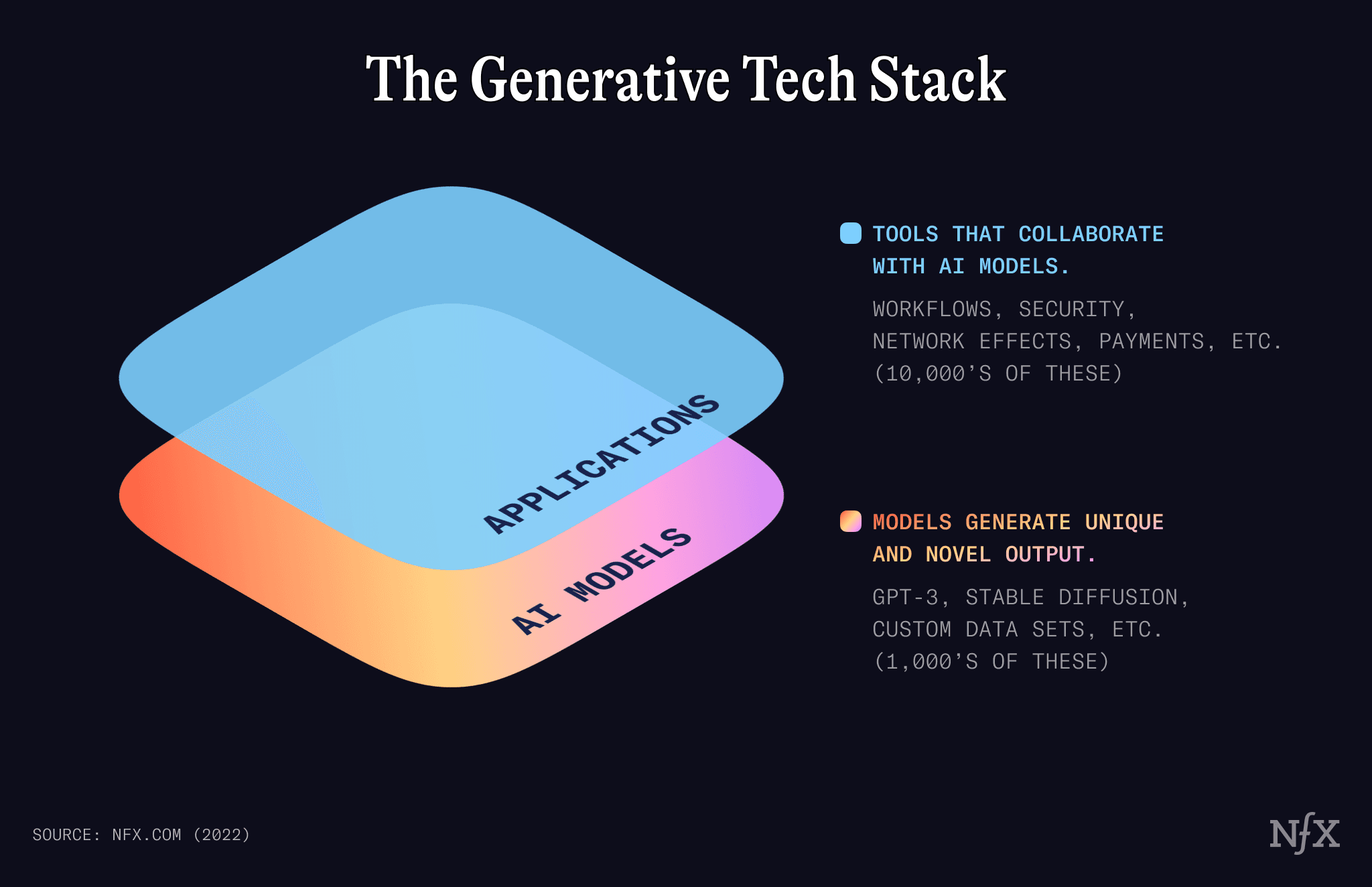

This stack will lower the technical barriers associated with certain fields. You don’t have to be an architect to generate drawings of a house remodel. You don’t have to be an illustrator to tell DALL-E what to draw. This is what allows Generative Tech to unlock new companies and projects.
These emergent companies have certain core characteristics that help place them on the Generative Tech continuum. Here are 3.
1. Zero to One → Zero to Ten
Generative Tech begins with solving a zero to one problem. The most successful companies will eventually provide zero to ten solutions, or, put differently, products that serve the complete needs of the user, and are uniquely animated by AI models.
You can imagine a version of Latitude’s AI Dungeon that combines the images and videos to match the text for complete gameplay experiences. Or allows you to create a persistent online persona using images or sounds generated with AI.
We already see examples of generative AI projects that provide near-finished products. Projects like SALT, a choose-your-own adventure, 70s-inspired sci-fi film, uses a combination of Generative Tech tools to rapidly generate videos (Stable Diffusion, MidJourney, DALL-E), write scripts (GPT-3), and generate character voices (Murf, Synthesia).
2. Replace Curation with Creation
Generative Tech is personalization in a way we have never experienced it before.
For 20 years, we have been chasing personalization through curation. E-commerce providers, Netflix and Spotify all want to serve you curated products you’re most likely to like from their central databases. FB, TikTok and The New York Times have experimented with curating your experience of their content.
This is a very limited approach to personalization because it is based on calling existing data. We have been trying to retrofit people’s preferences into our existing offerings, rather than generating new things that are best suited to them.
Generative Tech replaces curation with creation. Generative Tech is not a more sophisticated database call. It can be trained by that database, but its core function is to generate something new on the edge of the network.
Generative tech skillfully creates novel output. The content, images, or experiences served to you will not have existed until you asked for it, or triggered it through some other action or simply by your presence.
This is happening in the music space. Boomy, Amper, Aiva, Ecrett, SoundDraw and others are a company using AI to generate full-length, original songs in seconds. Boomy also gives creators the tools to share and monetize those creations, an example of a Generative Tech layered with SaaS tools. Critically, Boomy’s AI generates instant music that fits anything from a mood to a genre. That music has never been heard before YOU decided to create it.
In a pre-Generative Tech world, you might select a playlist for a road trip curated by someone else. In a post-Generative Tech world, you will generate entirely new songs that fit your occasion, mood, blood pressure, heart rate, location, and who you’re with, etc.
3. Low-Friction Interfaces
Perhaps the biggest breakthrough right now is how easy the Generative Tech tools are to use. So much heavy lifting is done by the AI models. Friction is removed from the creative process. DALL-E and Stable Diffusion require only simple text prompts to generate stunning artwork in 30 seconds.
Often the generation will be automatic. It will happen just by you showing up. You could imagine a version of SecondLife where two characters enter a house together, the house could generate something entirely new that fits both users’ personalities like art objects, experiences, music, and characters. Or if you sell something it automatically generates an NFT. Or, you could imagine displays of your life that pull from your photos, videos, texts and music. And they’ll be GOOD.
These will be the next level of human-machine collaboration. It’s a partnership where you get to be surprised and inspired.
What Will Generative Tech Companies Do?
Let’s break down where the next great Generative Tech idea will come from – and why it can come from you.
For your brainstorming, think: What if I marry one or more base layer AI models with…
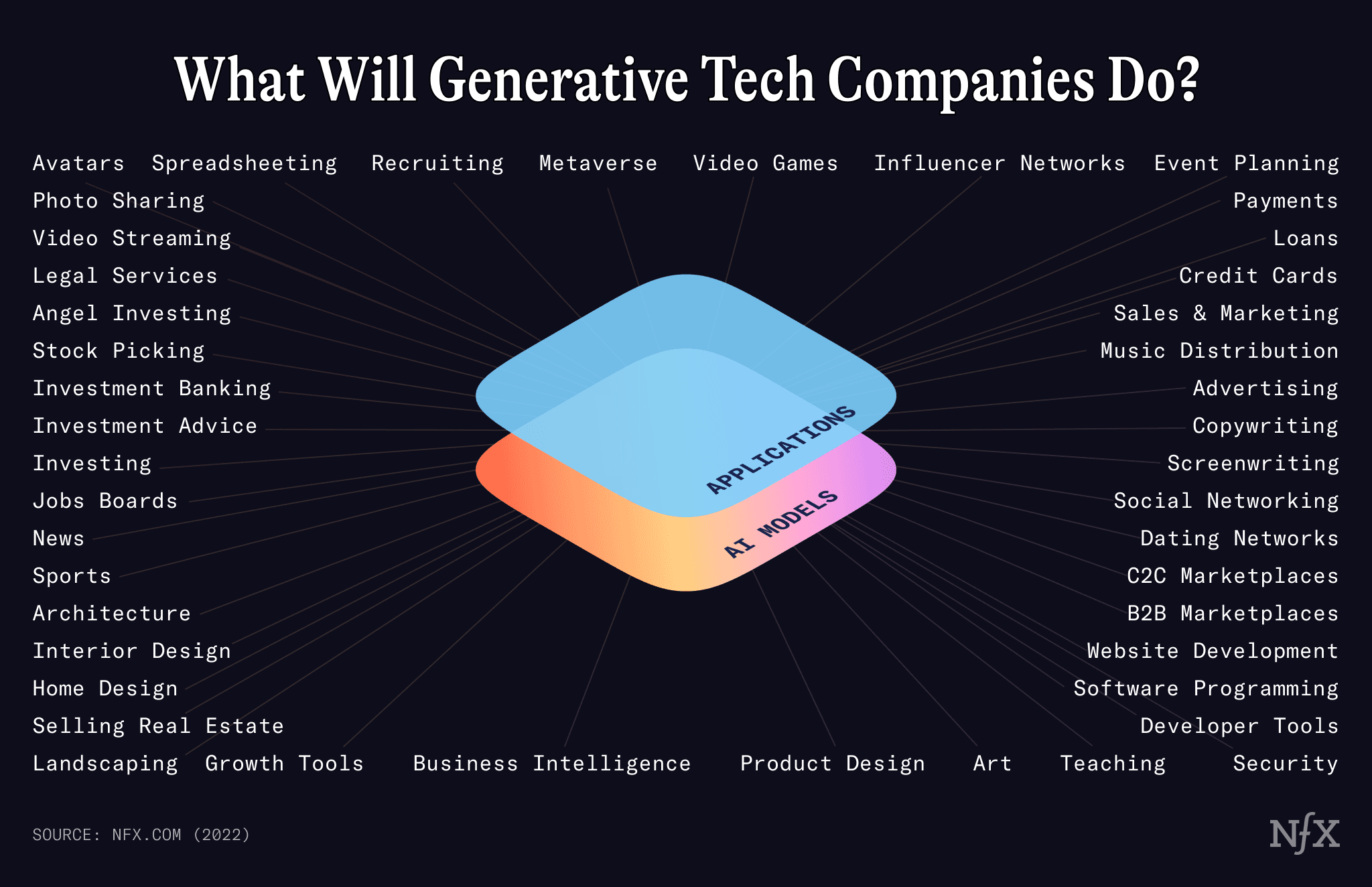

Potential Applications:
Avatars, Photo sharing, Video streaming, Legal services, Angel and VC investing, Stock picking, Investment banking, Investment advice, News, Sports, Architecture, Interior design, Home design, Selling real estate, Landscaping, Event planning, Payments, Loans, Credit cards, Sales, Marketing, Advertising, Copywriting, Screenwriting, Social networking, Dating networks, C2C Marketplaces, B2B Marketplaces, Website development, Website design, Software programming, Developer tools, Security, Growth tools, Business Intelligence, Invoicing, Spreadsheeting, Recruiting, Jobs boards, Art, Video games, Metaverse, Music distribution, Influencer networks, Product design, Teaching, Learning, Homework, Tutoring, Translating, Community management, Brand management, Customer loyalty, Lead generation, Pharmaceuticals, NFTs, Astrology, Fitness & Exercise, Watching TV.
AI Model Businesses
If you are Founders who build AI and ML models, go through the same list above and see if you can create the AI model for that specific area. If you have access to unique data, if you’re the first to see an application area, you can get a leg up by having the best model for a time in a specific area.
That advantage may not last and more general models might eat into your data advantage, or competitors selling an inferior – but still useful – model more cheaply, as has happened to the general models already in the last two years. Remember, data network effects are typically asymptotic. If you can make them real-time or hyper local, they are more durable.
Mental Models
Another way to land on a great Generative Tech idea is to think about how that business might work operationally.
- How can it have network effects where every new user adds value to every other user?
- How can it embed itself in a business or someone’s life so they don’t want to stop using it in the long run? This is Jasper’s job in 2023 to figure out.
- Where are there hyper local data sets for your AI model that you can own and maintain your data network effects despite competition coming in later?
- Where can you plug in to existing workflows, or a browser, or an app?
What function does the application serve?
Three quick functions that are clearly working today. There will be more over time.
1. Initial Ideas Collaborator
This helps solve the zero-to-one problem. These companies generate rough drafts or completed projects, and incorporate traditional SaaS tools to help perfect those drafts. Over time, we expect these companies to move toward creating finished products, but moving from zero to one is the first big step.
Tailorbird’s floor plan generation engine is a good example. It creates the first draft of a remodel. So are companies that generate ad copy or first drafts of code based on plain language inputs: companies like Copy.ai or Copysmith.
A company like jasper.ai, shows us how this path eventually leads to zero-to-ten solutions. Jasper.ai provides specialized writing and image capabilities across disciplines (copy, email, social etc). It’s a one-stop shop for your firm’s writing needs in all formats. They are now in the process of trying to embed that in a company so they can’t take it out, like an enterprise SaaS company does.
These products get the ball rolling on complex tasks, and let humans take it from there.
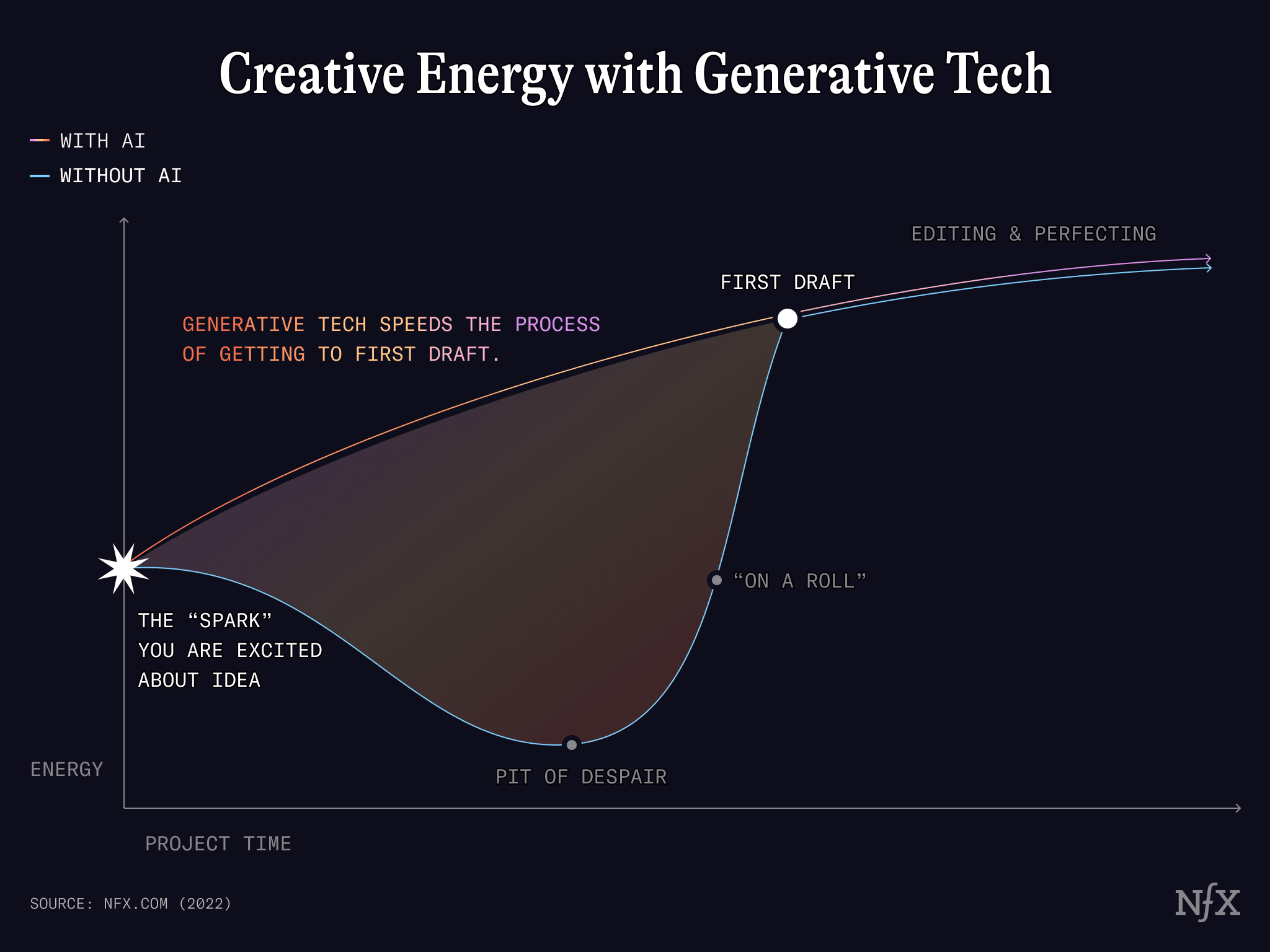

2. Coaching/Tailored Feedback
We learn through a process of trial and error. But we learn faster with a coach. We expect Generative Tech to analyze our performance, generate advice, or incorporate tools that allow us to hone our craft. Many of these applications might make some people feel uncomfortable at first. But they will challenge us to grow with the help of an AI collaborator. This is going to be the new normal.
3. Uniqueness At Scale
Uniqueness and scalability have historically been incompatible concepts. Truly unique things can’t exist en masse without losing their bespoke qualities. Generative Tech changes this. The generative engine is capable of providing a new output for every new user or every problem, at scale.
NFX-backed The.com allows you to generate hundreds of new websites all within one spreadsheet. These aren’t cookie cutter copies, they’re beautifully designed, and unique to the needs of each user.
An example from the biology world is Insilico Medicine. Insilico Medicine employs three AI-powered products that work together. One identifies new targets for drugs, while another generates new candidate molecules from scratch. Finally, the last engine predicts the outcome of clinical trials based on previous work. This is an elegant example of an analytical AI approach (identifying targets, and analyzing trial outcomes) combined with Generative Tech (generating novel molecular structures).
It’s similar to how snowflakes are generated in nature – millions fall during every storm, each totally unlike the one before it. But imagine that each one of those snowflakes could generate revenue for a business, cure a disease, or spark delight.
Founder Advice
Generative Tech will have unusual market dynamics because it’s already consensus
Typically, major tech shifts roll out slowly. Many people were still skeptical of the Internet until 2003, so those of us who believed had less competition. SaaS was gaining consensus from 1997 to 2005. Apple didn’t open their iOS platform to outside developers for 18 months after launch. Web3 has been rolling out for 10 years.
But everyone is on board with Generative Tech. The VCs get it. The Founders get it. The incumbents get it. And it’s clear that the game is now on.
What that means for Founders is 1) you have to move very, very fast. Boldness will matter. 2) You have to pick your idea very carefully. What you decide to build, who your target customer is, and what your distribution channels will matter a lot. There are patterns for what ideas work. You can go after a horizontal or a vertical, a particular data type or geography. There are many choices in the Generative Tech sector today.
As an example, there were 50+ social networks with the same 5 features when Facebook launched. Social networking was already “consensus.” But FB started with college students at Harvard and that turned out to be the right place to focus. You will have to make a similar focused choice in this consensus market.
How To Be Fast-Growing and Defensible in Generative Tech
If you’re building a Generative Tech business for enterprises, to grow fast, be prepared to be a plug-in to existing systems. Don’t try to replace workflows or replace existing software systems. To be defensible, embed in customers’ existing workflows and software. You’re seeing Jasper announce they want to be the browser plugin that gives all knowledge workers access to all the underlying AI models of text, images, etc. They won’t take it all, of course, but their plugin approach is correct on both counts: easy to implement and embedding in workflows.
Another good enterprise example is Tabnine, which mimics GitHub’s CoPilot code generator. It doesn’t replace the programmers’ code editor, it just sits on top for fast growth. What Tabnine did for defensibility is to build hyper-local data network effects for each company it serves around their exact code base, which locks those customers into Tabnine. Combining the embedding of the workflow with a protectable data moat is a good combination for durability.
If you’re building B2C, it’s more open-ended. Consumers love novelty, and are willing to adopt new behaviors faster. Just make sure to move fast and get a network effect.
If you are building for SMBs, it’s likely going to be in between something brand new and something that plugs in.
Speed Bumps
In Generative Tech, there are still questions of issues of copyright and safety, and I know first hand how real those are. Further, Founders should be concerned with NOT making weapons of mass social destruction. Further still, as Founders of an important company, you need to be a steward of society and not just your shareholders.
But great Founders step into the risks and solve the challenges quickly. Don’t let those concerns slow you down. Better to be thoughtful and good and also early on the field – to be the one figuring it out – rather than left behind, wringing your hands with a furrowed brow on the sidelines.
Founder Challenges
The biggest business risk at this stage of the market cycle (early) is that Founders don’t move fast enough into the seams opening in the market, and these technologies will simply become features and augmentations of the larger companies’ businesses. If you are Figma or SalesForce, you are scrambling to add such features ASAP. If you are SnapChat, same. Etc.
As a Founder, you need to pick your lane very carefully. As we discussed above. You want to find the fast moving water.
What Do Great Generative Tech Founders Look Like?
They look like you. This area is so new, and moving so fast, you can have an advantage in your chosen area in a few months… for now.
It’s Oct 2022. This window will close in months, not years. Find your area, find your seam – either technical, distribution, customer focus, geography focus, etc and hit it hard. Then give NFX a call for your seed capital. We invest $1-$4M, and we can help.
As Founders ourselves, we respect your time. That’s why we built BriefLink, a new software tool that minimizes the upfront time of getting the VC meeting. Simply tell us about your company in 9 easy questions, and you’ll hear from us if it’s a fit.
Try ChatNFX
